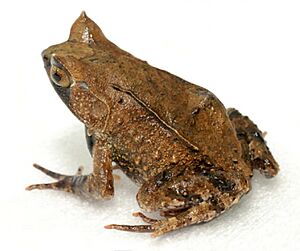Mindanao horned frog facts for kids
Quick facts for kids Mindanao horned frog |
|
|---|---|
 |
|
| Conservation status | |
| Scientific classification | |
| Genus: |
Pelobatrachus
|
| Species: |
stejnegeri
|
| Synonyms | |
|
Megophrys stejnegeri Taylor, 1920 |
|
The Mindanao horned frog (Pelobatrachus stejnegeri) is a special type of amphibian that lives only in the Philippines. It's known for its unique look, especially the small "horns" above its eyes. This frog is part of the Megophryidae family, which includes many other horned frogs.
You can find these frogs in wet, tropical forests, often near rivers. Sadly, their homes are shrinking, which puts them at risk.
Contents
About the Mindanao Horned Frog
The Mindanao horned frog was once known by a different scientific name, Megophrys stejnegeri. But in 2021, scientists decided to change its official name to Pelobatrachus stejnegeri. This change helps us understand how different frog species are related.
Where It Lives
This amazing frog lives only on the island of Mindanao in the Philippines. It loves places that are wet and damp. You'll often find it close to fresh water, like rivers, where it can lay its eggs. It also likes to hide in thick plants, fallen leaves, or other things covering the ground.
Mindanao has a tropical wet climate. This means it's usually warm and gets a lot of rain. The weather changes a bit depending on how high up you go, as some areas reach up to 2,700 meters (about 8,850 feet). The forests there have many types of trees and plants, from tall dipterocarp trees to mossy forests higher up.
The island has a rainy season from June to October, with frequent heavy rains called monsoons. From December to May, there are "trade winds" that bring less rain. During these drier months, it can be harder for the frogs to find wet spots to lay their eggs.
What It Eats
The Mindanao horned frog is a carnivore, meaning it eats other animals. Its diet depends on what insects and other small creatures live in the Mindanao forests. It mostly eats insects, but it also enjoys snails, spiders, and worms. Sometimes, if it finds a frog smaller than itself, it might even eat that!
Why It's in Danger
The Mindanao horned frog is currently listed as "vulnerable." This means it's at risk of becoming endangered if its situation doesn't improve. Its population is spread out in small groups, and the areas where it lives are getting smaller.
What is Habitat Loss?
The biggest threat to these frogs comes from humans. Many of the lowland forests where they live are being cut down for logging. When their homes disappear, the frogs have to compete for less food, water, and space.
Pollution is also a problem. Farming and mining activities can pollute mountain streams and rivers. This leaves fewer clean places for the frogs to lay their eggs and for their young to grow up safely.
Who Are Its Predators?
Many other animals on Mindanao also hunt the horned frog. Over 34 types of birds live there, and more than half of them eat these frogs. Some examples include the Mindanao scops owl, the Philippine eagle-owl, and the blue-capped kingfisher.
Besides birds, snakes and fish also prey on the frogs and their young. Even pets like cats and dogs can be a threat to these frogs if they wander into their habitat.


